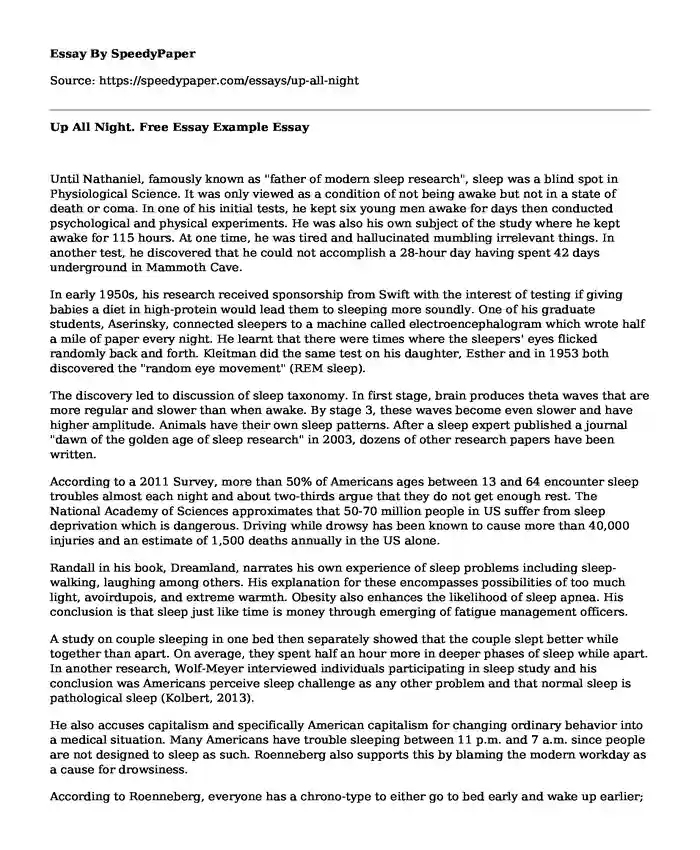
| Type of paper: | Course work |
| Categories: | Research Medicine Intelligence Anatomy |
| Pages: | 3 |
| Wordcount: | 802 words |
Until Nathaniel, famously known as "father of modern sleep research", sleep was a blind spot in Physiological Science. It was only viewed as a condition of not being awake but not in a state of death or coma. In one of his initial tests, he kept six young men awake for days then conducted psychological and physical experiments. He was also his own subject of the study where he kept awake for 115 hours. At one time, he was tired and hallucinated mumbling irrelevant things. In another test, he discovered that he could not accomplish a 28-hour day having spent 42 days underground in Mammoth Cave.
In early 1950s, his research received sponsorship from Swift with the interest of testing if giving babies a diet in high-protein would lead them to sleeping more soundly. One of his graduate students, Aserinsky, connected sleepers to a machine called electroencephalogram which wrote half a mile of paper every night. He learnt that there were times where the sleepers' eyes flicked randomly back and forth. Kleitman did the same test on his daughter, Esther and in 1953 both discovered the "random eye movement" (REM sleep).
The discovery led to discussion of sleep taxonomy. In first stage, brain produces theta waves that are more regular and slower than when awake. By stage 3, these waves become even slower and have higher amplitude. Animals have their own sleep patterns. After a sleep expert published a journal "dawn of the golden age of sleep research" in 2003, dozens of other research papers have been written.
According to a 2011 Survey, more than 50% of Americans ages between 13 and 64 encounter sleep troubles almost each night and about two-thirds argue that they do not get enough rest. The National Academy of Sciences approximates that 50-70 million people in US suffer from sleep deprivation which is dangerous. Driving while drowsy has been known to cause more than 40,000 injuries and an estimate of 1,500 deaths annually in the US alone.
Randall in his book, Dreamland, narrates his own experience of sleep problems including sleep-walking, laughing among others. His explanation for these encompasses possibilities of too much light, avoirdupois, and extreme warmth. Obesity also enhances the likelihood of sleep apnea. His conclusion is that sleep just like time is money through emerging of fatigue management officers.
A study on couple sleeping in one bed then separately showed that the couple slept better while together than apart. On average, they spent half an hour more in deeper phases of sleep while apart. In another research, Wolf-Meyer interviewed individuals participating in sleep study and his conclusion was Americans perceive sleep challenge as any other problem and that normal sleep is pathological sleep (Kolbert, 2013).
He also accuses capitalism and specifically American capitalism for changing ordinary behavior into a medical situation. Many Americans have trouble sleeping between 11 p.m. and 7 a.m. since people are not designed to sleep as such. Roenneberg also supports this by blaming the modern workday as a cause for drowsiness.
According to Roenneberg, everyone has a chrono-type to either go to bed early and wake up earlier; "Larks" or stay up late and wake up later in the morning; "Owls". The expectation to get to work by 9 a.m. makes "Owls" wake up two or three hours before what their chrono-type dictates. For "Larks" social life becomes hard.
Kolbert, narrates her experience in self-experimentation following her difficulty in sleeping between 11 p.m. and 7 a.m. She checks herself in the Sleep Disorder Center in Albama. At about 10 a.m., a technician measures her data stream by attaching electrodes all over her body. After switching off the lights, every movement she made got tangled in a wire. Her attempts to remove the wires were futile as the technician would plug them back in. Several hours in, she got sleep and was awoken by at 6 a.m. craving for coffee.
The results of the experiment showed that she cycled from wakefulness via every stage 1, 2, 3, and rem of sleep. Good sleepers have sets of facing staircases in the hypnogram. In particular, for her, the graph indicates that she fell asleep four different times and slept in different intervals. She also stops to breathe four times but it is normal. The doctor advised that she does not go to sleep until she was sure that she was exhausted, avoid alcohol, and read in another room but not in bed to help curb her diagnosis of "difficulty with sleep maintenance" (Kolbert, 2013).
Having implemented the recommendations, her hypnogram indicates that nights have become harder. In conclusion, she states that sleep is crucial but remains a mystery. As Randall highlights in his journal, Dreamland, the more you become increasingly aware of it, the more its strangeness unnerves you (Kolbert, 2013).
References
Kolbert, E. (2013, March 03). Up All Night. The science of sleeplessness. Retrieved from https://www.newyorker.com/magazine/2013/03/11/up-all-night-2
Cite this page
Up All Night. Free Essay Example. (2023, Jan 25). Retrieved from https://speedypaper.com/essays/up-all-night
Request Removal
If you are the original author of this essay and no longer wish to have it published on the SpeedyPaper website, please click below to request its removal:
- MBTI and DISC Comparison And Contrast
- Education Essay Sample: A Reading Task That Is Difficult for Me
- Free Essay on Oscar Awards Winning Actor Leonardo DiCaprio Biography
- Feasibility Report - Business Essay Example
- Essay Exampleon Processor Management in UNIX Operating System
- Free Essay: Do Patients Receive Better Quality Care in Non-Profit or For-Profit Facilities?
- Free Essay Sample - Software-Defined Network
Popular categories




